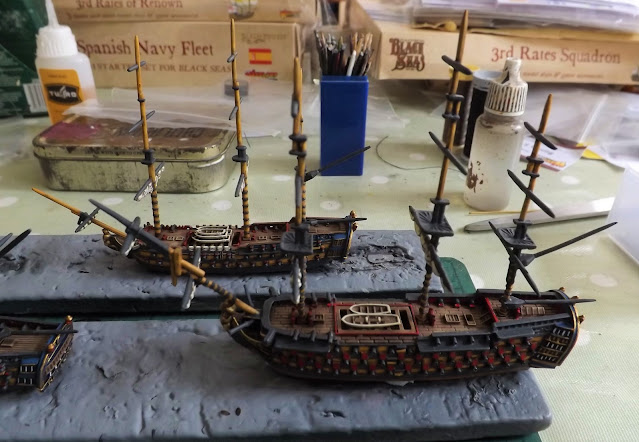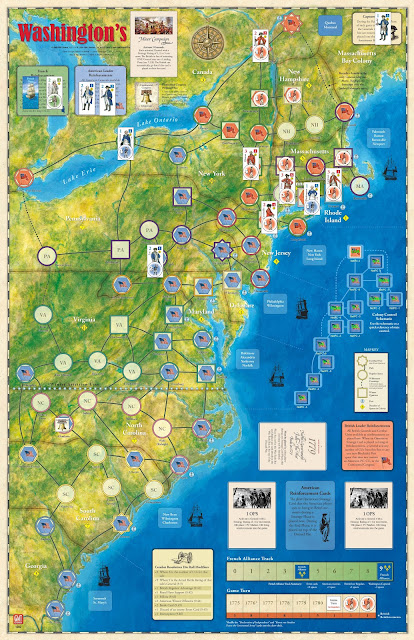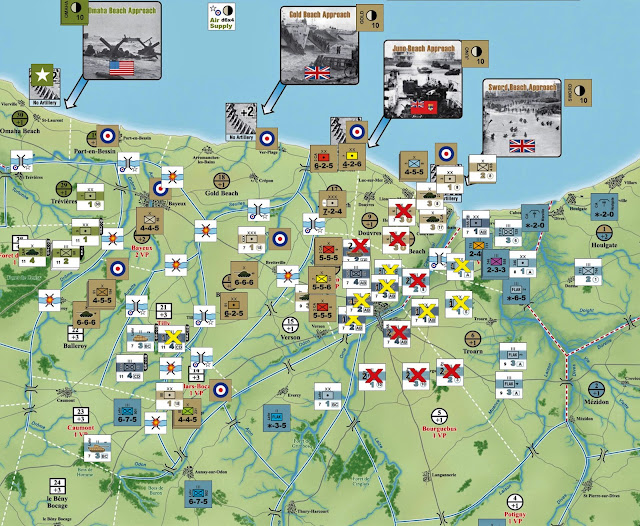My reading list from the Age of Sail has been updated with my recent reading of Dr Sam Willis' 2015 title covering the maritime war of the American War of Independence (AWI).
Although my current modelling project is very much focused on the naval forces of the era that followed this struggle, namely the French Revolution and Napoleonic Wars, the links to the way that latter naval war was conducted and fought, lie very much in this earlier period, and I was conscious of a gap in my knowledge about the conduct of the naval war in the AWI that I hoped this book would inform.
My interest in the AWI has always been more inclined towards the war on land in America, with a good understanding of that aspect together with a limited interest in the naval aspect focused on Suffren's campaign off the Indian coast, around which I built a collection of Langton 1:200th models, which encouraged further reading.
However any student of the French Revolutionary and Napoleonic era soon realises that the rise and success of the Royal Navy in that period clearly had its roots in this earlier war and the commanders who led that navy developed the strategy and tactics from the experience gained between 1775 to 1783 and gained a better understanding of how to wield sea power globally with its ability to project power and influence events on land.
 |
The Struggle for Sea Power is careful to include the contribution of the freshwater navies, and reminded me of the picture I took back in 1988 on a visit to the National Museum of American History in Washington DC, and the amazingly preserved hull of the gondola Philadelphia, recovered in 1935, part of General Benedict Arnold's fleet of hastily constructed boats on Lake Champlain, that resisted Carleton's expedition around Valcour Island in 1776
|
Dr Sam Willis is a leading maritime historian, archaeologist, and broadcaster with several naval histories from the Age of Sail to his credit, one of which I reviewed here previously, 'Fighting at Sea in the Eighteenth Century, The Art of Sailing Warfare' which I thoroughly enjoyed and so was looking forward to reading this next book by him.
What I found particularly interesting in this book was Willis sets his stall out right from the start in how he constructed this history basing the work around five rules:
- A naval history that includes reference to the formal and informal navies that characterised the war with the national and state navies together with the privateer fleets,
- The scope to cover the war on the rivers and lakes as well as at sea,
- The global nature of the war that included alongside the fleets from the US, France and Great Britain, those of Spain, Holland, Russia, Denmark, Sweden, the East India Company, the Bombay Marine and native American Indians, and
- A joining up of all the dots by linking the effects of war between the navies in widely separated theatres influencing each other.
His final rule five set out to highlight how all sides involved in the conflict had expectations of sea power that were often disappointed with a clear mismatch of the expectations and an understanding of the unique aspects that control of the water, be that riverine or maritime could deliver; which as a theme constantly seeks to illustrate how, when the role of sea power was exploited effectively by all the combatants, its effect could be dramatic and war changing.
 |
A contemporary watercolour of Arnold's fleet at Valcour Island in 1776 with the sloop, Royal Savage in the centre and with the gondola, Philadelphia, seen above, shown second from left - Courtesy of the National Archives of Canada.
|
This latter rule was so clearly emphasised for me by the chapter covering the impact of the lack of cooperation between the French admiral d'Estaing and American Major-General Sullivan off Rhode Island in 1778, following the great excitement and anticipation French naval power seemed to offer American capability in the land war; when the French admiral departed the American coast after the effects of storm damage and a robust resistance from British Admiral Howe's smaller squadron seem to convince the French commander that he needed to be anywhere else other than helping his American allies to capture Newport.
 |
| D'Estaing and his dismasted flagship Languedoc 80-guns narrowly escaped capture following the storm off Rhode Island in 1778, when attacked by Captain George Lawson's HMS Renown 50-guns, part of Howe's British squadron. |
The effect was to leave the American's hugely disappointed and Sullivan's troops unemployed the following year, with Washington having no idea where the French fleet was or if it was coming back, with d'Estaing having departed for the Caribbean. Thus it was that Sullivan's troops had time on their hands to head up to the Mohawk Valley area and devastate the Iroquois Indian settlements, a deployment that had previously baffled me when purely focusing on the land war, but now makes complete sense, with the Mohawk valley being such an important food resource for the American army and in desperate need of relief and with troops more than capable and available to take punitive action.
 |
Washington crossing the Delaware - Emanuel Leutze
A somewhat fanciful and romanticised rendition of Washington's several crossings of the Delaware River in December 1776, captures well the impact of John Glover's Marblehead men in enabling safe passage of this large river in winter for the American general and his army to conduct a surprise campaign that would drive the British out of New Jersey and its rich supply base. |
Willis takes pains to stress how important it was for the land forces to cooperate closely with the maritime forces when operating on or close to water, which was a natural consequence of operating along the extensive coast line of the American colonies and in the vast open tracts of colonial North America where large fast flowing rivers and great lakes were a major feature of the landscape.
As well as the ability to land on or blockade the American shoreline, very often it was the same sailors from the respective navies and their commanders who were recruited to enable the armies to operate on these fresh water obstacles and where the cooperation was effective, very often the results of that collaboration paid dividends, with examples of the Marblehead sailors led by John Glover who enabled Washington to escape from Brooklyn and his later crossing of the Delaware during the American winter offensive that led to the actions at Princeton and Trenton.
 |
The Siege of Charleston, March 29th - May 12th 1780 - Alonzo Chappel
Just under 5,500 troops together with tons of stores, munitions and shipping fell into British hands, the worst surrender of US troops until 1862, illustrated the benefits to be had by coordinated command from land and sea. |
Likewise General Clinton's successful attack on Charleston, South Carolina in 1780 was more than enabled by the close support by the Royal Navy on the sea and on land with sailors under the able command of Captain George Elphinstone who like Glover and the Marblehead men worked with the army, transporting guns taken from the supporting warships to bombard the city on land after the British siege train was lost at sea on route, and enabled the army to outmanouvre American defences in the swamps and marshes of the River Ashley using flat bottomed boats to transport the troops with muffled oars to avoid detection.
Where that cooperation sadly lacked the consequences could be disastrous, with General John Burgoyne's seemingly ludicrous decision, amongst others, to leave Skennesborough at the bottom of Lake Champlain and march off on a sixteen mile hike through the woods, dragging a hundred bateaux over bogs and thickets and crossing the same creek forty times in pursuit of the Americans who naturally turned to fight in terrain perfectly suited to their tactics. The alternative being, with British ships controlling the waterways, to return back up Lake Champlain and take his army on prepared boats down Lake George leaving just a short march on well used roads to Fort Edward on the River Hudson.
Willis outlines how both France and Spain were careful and deliberate in their timing of entry into the war not to be pulled in until their preparations were complete. In Spain we see the first signs of their decline as a leading power with their forces unable to make an impact until they combined their efforts with France, which was not without inherent problems.
This decline in Spanish capability is best reflected in the inability of the Franco-Spanish fleet to break into the English Channel to enable an invasion of the British Isles and their failure to prevent a resupply of Gibraltar together with repeated attempts to take the rock, after they had made it the centre piece of their agreeing to enter the war with France in the first place. Overstretch of the Royal Navy would enable them to take Minorca and to capture a very large British convoy off Spain, but of their few successes perhaps Bernado de Galvez, Governor of New Orleans deserves the most credit for engineering British woes along the Mississippi and the capture of Pensacola with his combined operations using a limited naval capability to rapidly move his forces and take full advantage of British weakness.
The take-home messages for me was that the British political management of the naval conflict as with that on land was a woeful performance by Lord North and his government, offset somewhat by the leadership of key admirals such as Howe and others who had to often defend British interests with overstretched and inadequate resources given the cuts to the navy before the war, only made up for from about 1778 onward as the Admiralty geared up for global conflict.
The British were clearly aided by the Bourbon navies of France and Spain being often unable to cooperate to combine their strengths to overwhelm the Royal Navy, coping with the built in distrust that haunted the alliance against a common foe. That and the technical differences between the opposing fleets with the gradual improvement in the Royal Navy's ability to operate for longer periods at sea and avoid the sickness levels from poor hygiene and inadequate nutrition that continued to take its toll on the French and Spanish sailors, whilst less so in the Royal Navy.
 |
The Spanish ship San Domingo explodes before HMS Sandwich, flagship of Admiral Sir George Rodney at the Battle of Cape Vincent, 16th January 1780, otherwise known as the Moonlight Battle by Richard Paton
|
With the advent of British developments such as the carronade and coppering of their ships hulls, the latter carried out amazingly quickly and at great expense, this combined with the rapid ship building programme initiated on the entry of France into the war, the tide of war at sea was turned and prevented the loss of even more of the British Empire than might have been the case without them, and with the improvement in British tactical methods and the aggressive approach demonstrated by commanders like Admiral Rodney at the the Moonlight Battle against the Spanish in 1780 and the Saintes against the French in 1782, laid the foundation for their greater battle effectiveness in latter periods as well as a strong negotiation position during the peace talks.
 |
The Battle of Flamborough Head, 24th* September 1779 - Richard Paton
Captain John Paul Jones and the US 40-gun ship Bonhomme Richard defeats the 44-gun HMS Serapis, one of the most hard fought actions of the war, that left both ships very badly damaged and saw the Bonhomme Richard sink two days later. Captain Richard Pearson was knighted by King George III for his defence of the Baltic convoy, all of which escaped capture and effectively ended Jones' cruise.
* Note the date for this battle, highlighted in Sam Willis' account, is the 24th not the 23rd quoted in many accounts, including that on Wikipedia! |
In amongst the great naval events of the war Willis weaves in the other no less important aspects such as the war waged by privateers and the state fleets, with the exploits of characters like John Paul Jones, who along with William Bingham in the Caribbean were able to take the war into British waters in a way that the fledgling Continental Navy was never able to do.
We see the rise of the tension that would be a key part of the French Revolutionary and Napoleonic period in the Baltic as Russia sought to take advantage of perceived British weakness and British blockades of France and Spain and the insistence of their policy of stopping, searching and if necessary confiscating merchantmen from Sweden, Denmark and Russia, found carrying supplies to enemy ports. This Russian manoeuvring would bring the Dutch into the war, much to their cost, that would see their naval power and overseas holdings taken apart by British naval power, keen to remove the threat from just over the Channel and to take or neutralise important overseas holdings in the Caribbean, Indian Ocean and the Cape where Dutch traders had been profiting hugely from the British war whilst supplying her enemies at a very advantageous price.
 |
Vice Admiral Sir Edward Hughes gets a much more sympathetic appraisal from Sam Willis, which chimed with my own thoughts. The admiral compares very favourably alongside, to quote Willis 'the useless' Thomas Graves.
|
Finally one of the interesting aspects of this read was the characters described who shaped the outcome of the war, two of whom stuck with me, namely the irascible Admiral Sir George Rodney, who though gifted with great talents in leading fleets in battle, displayed less admirable qualities of self enrichment at the expense of the greater war effort, repaying the Dutch for their trading pursuits in the taking of the Dutch island of St Eustatius (now I know what that card refers to in Washington's War) and his somewhat disregard for the chain of command when it suited, and Admiral Sir Edward Hughes who has often appeared in other naval histories as rather unimaginative and plodding but who Willis takes pains to recognise for his ability to manage well the limited resources at his command and to fight a successful defensive campaign that ensured the Indian sub continent would remain firmly in British hands at the close of the war.
I really appreciated the approach to the layout of the book in that my understanding of the naval war in the AWI and its wider impact on the war as whole gained a much clearer understanding as Willis, whilst describing the events of a particular campaign in a particular theatre, constantly took the reader back to the impacts the events described had on other theatres and the conflict as a whole.
In addition I came away from reading it with a much better understanding of the learning process the British naval and military leadership went through in this war in understanding the need for close cooperation in combined operations. Of course these lessons would need to be relearned as a new war commenced after the previous one, but the tactical success of the landings in Aboukir Bay and the wider cooperation between British naval leaders and the army in the Peninsular War that followed can trace a path of experience gained from the Howe brothers landing an army off New York with great success and planning in 1776 and would become a key factor that would allow British power to be projected so successfully around the globe in the next century and beyond.
The Struggle for Sea Power, A Naval History of American Independence is 587 pages that includes:
List of Illustrations
Sixteen Colour
Twenty-Four Black & White
 |
The charts in this book are extensive and well executed to follow the text
|
List of Charts:
America Before the War
Rhode Island
Boston
New York to Quebec, Part 1: New York and the Lower Hudson
New York to Quebec, Part 2: Hudson Highlands and Lake Champlain
New York to Quebec, Part 3: St Jean to Quebec
Northern Europe
The Caribbean
The Red Sea and India
The Gulf Coast
The Chesapeake Bay
Gibraltar
The Invasion of Canada
The Pennsylvania Campaign
Philadelphia
Savannah
Penobscot
Charleston
Foreword
Preface
Introduction
PART 1 American Revolution, 1773 - 1775
1. British Pyre
2. American Origins
3. European Gunpowder
4. Canadian Invasion
5. Colonial Sea Power
6. British Evacuation
PART 2 Civil War, 1776 - 1777
7. British Attack
8. Freshwater Fleets
9. American Riposte
10. British Surrender
11. American Sea Power
PART 3 World War, 1778 - 1780
1778
12. Bourbon Alliance
13. French Firepower
14. British Survival
15. Caribbean Sea
16. Indian Empire
1779
17. Spanish Patience
18. Bourbon Invasion
19. British Resourcefulness
20. Caribbean Crisis
21. French Incompetence
22. American Destruction
1780
23. British Dominance
24. Allied Recommitment
24. Spanish Skill
26. Russian Meddling
PART 4 American Independence, 1781
27. Dutch Disaster
28. British Obsession
29. French Escapes
30. Allied Success
Epilogue
Glossary of Nautical Terms
Notes
Bibliography
Index
The book in hard copy retails at a list price of £30 but at the time of writing Amazon are listing new copies available for as little as £10.95 which is a steal for this quality of book.
Next up - Work progresses with the Spanish Fleet in All at Sea and more adventures from Washington's War in Vassal











































